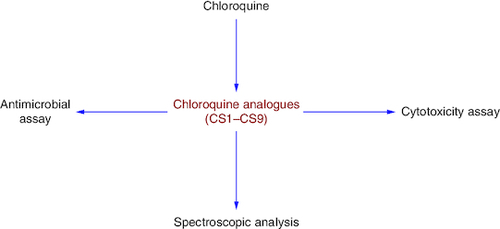Abstract
Aim: To synthesize novel chloroquine analogues and evaluate them for antimicrobial and cytotoxic potential. Methods: Novel analogues were synthesized from chloroquine by nucleophilic substitution reaction at the 4-amino position. Results: Analogue CS1 showed maximum antimicrobial potential (30.3 ± 0.15 mm zone) against Pseudomonas aeruginosa and produced a 19.2 ± 0.21 mm zone against Candida albicans, while CS0 produced no zone at the same concentration. Analogue CS9 has excellent cytotoxic potential (HeLa cell line), showing 100% inhibition (IC50 = 8.9 ± 1.2 μg/ml), compared with CS0 (61.9% inhibition at 30 μg/ml). Conclusion: These synthesized chloroquine analogues have excellent activity against different microbial strains and cervical cancer cell lines (HeLa) compared with their parent molecule.
Novel chloroquine analogues were synthesized by nucleophilic substitution reaction at the 4-amino position.
These analogues were characterized using nuclear magnetic resonance and Fourier transform infrared spectroscopic techniques.
The antimicrobial result showed that the new analogues have good antimicrobial activity, while chloroquine was not active against any strain.
In the cytotoxicity study, a few analogues had improved activity compared with chloroquine.
Docking results also support in vitro findings due to good binding affinity.
Financial disclosure
The authors have no financial involvement with any organization or entity with a financial interest in or financial conflict with the subject matter or materials discussed in the manuscript. This includes employment, consultancies, honoraria, stock ownership or options, expert testimony, grants or patents received or pending, or royalties.
Competing interests disclosure
The authors have no competing interests or relevant affiliations with any organization or entity with the subject matter or materials discussed in the manuscript. This includes employment, consultancies, honoraria, stock ownership or options, expert testimony, grants or patents received or pending, or royalties.
Writing disclosure
No writing assistance was utilized in the production of this manuscript.
Acknowledgments
The authors acknowledge COMSATS University, Islamabad, Pakistan, and HEJ Research Institute, University of Karachi, Pakistan, for providing excellent research facilities.

